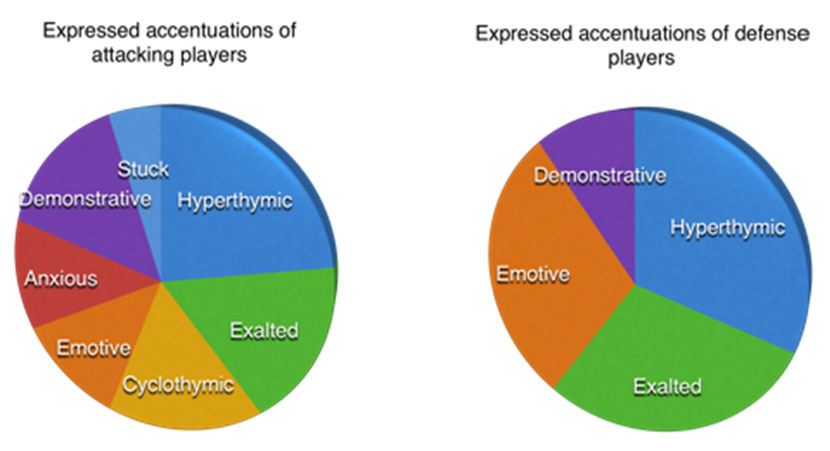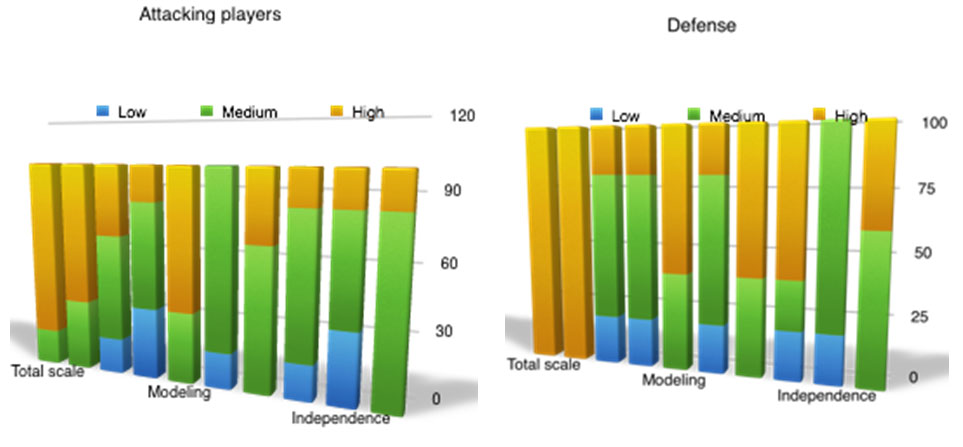Personality and Psychomotor Characteristics of Roles in Women's Futsal
Фотографии:
ˑ:
L.E. Nakonechnaya
E.V. Romanina, professor, Ph.D.
Russian State University of Physical Culture, Sport, Youth and Tourism (SCOLIPC), Moscow
Key words: psychological training, women's sport, futsal.
Introduction. Futsal is getting more popular both in the world and in our country. From year to year our team wins prizes in world and European championships. Women's Championship has been held since 2010 and so far is unofficial, but is getting more important. In December 2013 our team was a bronze-winner.
Development of women's football in general and futsal in particular is a promising direction, which is defined as one of the leading at the top European level. ”The key goal of UEFA is to increase the large-scale involvement in European women’s football. The European Football Union will keep on supporting associations in the issues related to further development of women’s football”, – Karen Espelund, the head of the UEFA Women’s Football Committee, said. However, the popularity of this sport in our country is much inferior to that in the European countries. The relevance of training and developing players' potential, detecting the guidelines for organizing not only technical and tactical, but also psychological training are the priority directions.
Identifying the distinctive features of working with a team, given the specificity of this sport, creating a differentiated approach to players to revel their potential to the maximum and improving competitiveness of team in general are important tasks for both a coach and a psychologist. Most often players are differentiated in a team based on game positions. In all games they quite clearly define player’s functions, and technical and tactical actions are based on them. However, game situations in futsal are significantly different from those in other sports games, in particular in regular football. The number of players and the size of the field, speed, dashes, quick change of direction, and the fact that all players takes part in both attacks and defense - all this makes the difference not only in technical and tactical actions, but also in personality traits of players.
The purpose of the study was to identify the differences or similarities of psychomotor characteristics and personality traits of female futsal players.
Materials and methods. The methods included computer tests of psychomotor reactions using the program «UPDK - MK» (universal psychodiagnostic system), «aSTARTa», the methodology for studying personality accentuations by K. Leonhard (adapted S. Shmishek version), the questionnaire of volitional self-control (VSC) by A.G. Zverkov and E.V. Aidman, the test “Style of behavior self-regulation” by V.N. Morosanova; mathematical methods of data processing: the Mann–Whitney U test, descriptive statistics (Excel 2007).
Twelve futsal athletes (Ist senior degree, Candidate Master of Sport, Master of Sport and Master of Sport of International Level) were involved in the study that was conducted in «Snezhanna» football club in the town of Kotel’niki.
Results and discussion. Psychomotor characteristics of female futsal players in terms of reaction to a moving object (Table 1) differ slightly for representatives having different positions. The general trend was a slight shift in the direction of the inhibition reactions, the indicators of the reaction time differed, but the statistically significant differences were detected only in simple reaction time: attacking players are characterized by a quicker response compared with defenders (at p <0,01), the choice reaction under stress was in the uncertainty zone.
Table 1. Psychomotor characteristics of female futsal players with different game positions
|
Game position |
Reaction to a moving object (out of 30) |
Simple reaction, m/s |
Reaction of choice between two alternative s |
Reaction of choice between two alternatives under stress |
||||
|
delayed reaction |
antedating reaction |
precise reaction |
speed, m/s |
mistakes |
speed, m/s |
mistakes |
||
|
Attack |
12.7 ± 0.8 |
7.0 ± 0.5 |
10.2 ± 0.5 |
0.311 ± 0.010 |
0.407 ± 0.006 |
1.0 ± 0.3 |
0.380 ± 0.012 |
1.0 ± 0.2 |
|
Defence |
13.8 ± 1.7 |
5.2 ± 1.1 |
10.8 ± 1.2 |
0.342 ± 0.008 |
0.438 ± 0.022 |
1.0 ± 0.5 |
0.457 ± 0.030 |
1.0 ± 0.3 |

Figure 1. Intensity of types of character accentuations of female futsal players according to the K. Leonhard’s classification of personality accentuations (adapted S. Shmishek version), %
The data on character accentuations of female futsal athletes with different positions (Fig. 1) reveal the obvious similarity of some of the scales, expressed hyperthymic, cyclothymic temperamental characteristics, the lack of expressed dysthymia, excitability; these features must be typical of female futsal players. On Figure 1 we can see significant the differences in character traits. The Mann - Whitney U-test was also employed to carry out a statistical analysis of the data to clarify the differences. In addition to the data on expressed accentuations, the data on the tendencies and lack of accentuations were mathematically processed. In the end it turned out that significant differences were determined only in the dysthymic character accentuation at р<0.05; such indicators as “excitability” and “anxiety” were in the uncertainty zone, the rest of the accentuations differences did not reach the statistical significance level.

Figure 2. Levels of volitional self-control and self-regulation features of female futsal players, %
The comparison of scales’ expressiveness degree (Fig. 2) shows some differences between players with different game positions, but their significance has not been confirmed mathematically, except for the “flexibility” scale that turned out to be in the uncertainty zone. These characteristics must reflect the specificity of futsal where each player can be in the situation of both attack and defense; and the specifics of planning, modeling and programming of their actions, actions of opponents and players of their team should be typical for all regardless of game position and are perhaps determined by the team qualification that is yet to be explored.
Conclusions. The detected differences between players in various game situations help a coach and a psychologist to apply the differentiated approach to the organization of the training process. Interchangeability in this sport is very important, therefore, a certain universality of the player largely contributes to his performance. When working with a team a coach and a psychologist need to pay attention to the team spirit of players, forming their mutual understanding and "feeling of player". Persuasive care of defenders, tough regulation of activity and directive methods are not recommended for increasing stress tolerance and precise reaction. Psychological preparation of attacking players should by all means include increase of self-control, mental training and psychomuscle training. It is important for players to trust their trainer and players.
References
- Methodology for studying personality accentuations by K. Leonhard (adapted S. Shmishek version) / Workshop on personality psychodiagnostics; ed. by N.K. Rakovich. – Minsk: Tank BSPU, 2002. – 248 P. (In Russian)
Corresponding author: nle13@mail.ru



